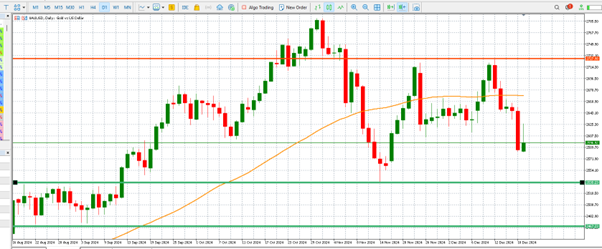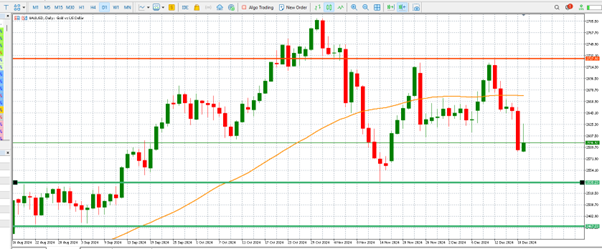Today, gold prices plummeted to a new one-month low before rebounding by more than 1% as investors analysed the Federal Reserve's most recent interest rate decision and indications of a progressive easing policy in the coming year. Spot gold increased by 1.1% to $2,617.14 per ounce, marking its highest level since November 18, while U.S. gold futures declined by 0.8% to $2,631.10. The yellow metal is still under pressure, despite the recovery that occurred today, as a result of the Federal Reserve's hawkish commentary, which has altered market expectations for the upcoming months.

Gold trading price chart by XTB
The Federal Reserve's decision yesterday was unexpectedly hawkish.
The Federal Reserve's decision to reduce its interest rate from 4.75% to 4.5% yesterday was widely anticipated; however, the tone of their statement caught market participants off guard. The Federal Reserve's hawkish commentary has diminished expectations for a rapid rate-cutting cycle in 2025, indicating a more measured approach to monetary easing. This unexpected tone precipitated a significant decline in gold prices, as investors revised their expectations for the upcoming year.
The Fed's posture is indicative of its ongoing apprehension regarding inflationary pressures, despite the fact that the U.S. economy is exhibiting evidence of resilience. Although the rate reduction offers some respite to the markets, the Federal Reserve's emphasis on maintaining a close control over inflation has diminished investor interest in non-yielding assets such as gold. The sell-off that occurred yesterday was a direct response to these dynamics, as market participants reevaluated the outlook of gold in relation to the Federal Reserve's longer-term monetary strategy.
Gold's Future: Key Levels and Consolidation
Gold prices are expected to undergo a period of consolidation following the Federal Reserve's final meeting of the year. The absence of significant market-moving events for the remainder of the year suggests that gold may continue to decline, potentially testing the next critical support level at $2,483 per ounce. This level will be a critical indicator for traders, as a breach could potentially lead to additional losses.
Simultaneously, the metal is anticipated to receive some support from bargain hunters at the $2,500 level. Investors seeking to capitalise on perceived undervaluation have historically shown an increased interest in purchasing at such psychological price points. Nevertheless, the bullish trajectory of gold is still unlikely to be sustained in the near term, as the broader macroeconomic environment remains unfavourable.
A Less Promising Outlook for 2025: A Comprehensive Overview
The outlook for gold in 2025 appears to be less remarkable than it has been this year. A less favourable environment for the yellow metal is being created as a result of the convergence of several factors:
Rate-Cutting Cycle Deceleration: The Federal Reserve has indicated that the rate of rate cuts is expected to decrease significantly in the coming year. This cautious approach to monetary easing will diminish one of gold's primary tailwinds, as lower interest rates typically reduce the opportunity cost of holding non-yielding assets such as gold.
Reduced Geopolitical Tensions: The geopolitical landscape may undergo a transformation towards decreased tensions as Donald Trump assumes office in January. Throughout history, gold has prospered amid periods of geopolitical unrest, as investors seek refuge in safe-haven assets. The appeal of gold as a crisis hedge may be diminished if tensions subside under the new administration.
A More Robust Dollar Environment: In 2025, the dollar may become more robust due to the Fed's hawkish posture and the resilience of the U.S. economy. Gold prices are generally subject to downward pressure when the dollar is strong, which results in the metal being more expensive for holders of other currencies.
Mixed Sentiment Regarding Short-Term Prospects
Market sentiment towards gold remains inconsistent in the near future. The metal's rebound today suggests that there is still a demand for it, particularly as investors evaluate the Federal Reserve's communication. Nevertheless, it is impossible to disregard the fundamental pressure emanating from a hawkish Federal Reserve and robust dollar trends. In order to assess the economy's health and its potential impact on gold prices, traders are expected to closely monitor forthcoming economic data, such as inflation and employment reports.
Furthermore, the price of gold in the concluding weeks of the year may be influenced by seasonal factors. Reduced trading volumes are frequently observed during the holiday season, which can exacerbate price fluctuations. Although this presents opportunities for short-term gains, it also introduces increased volatility, necessitating that traders exercise caution.
Conclusion: A Critical Period for Gold Markets
The difficulties that gold is encountering as it navigates changing macroeconomic dynamics are underscored by its recent price fluctuations. Although the current recovery provides some optimism for stabilisation, the broader trend continues to be under pressure as a result of the Federal Reserve's hawkish commentary. The market's focus will now transition to the manner in which gold navigates this period of consolidation, with the $2,500 and $2,483 levels in focus.
The outlook for gold in 2025 is less optimistic due to a potential strengthening dollar, reduced geopolitical tensions, and a declining rate-cutting cycle. Although gold will unquestionably continue to be a safe-haven asset, its capacity to generate extraordinary returns, as demonstrated this year, may be restricted. Traders and investors should anticipate a more cautious environment in the near future as the factors that influence the price of gold continue to develop.
